利息率与汇率的关系
- 格式:ppt
- 大小:116.07 KB
- 文档页数:18
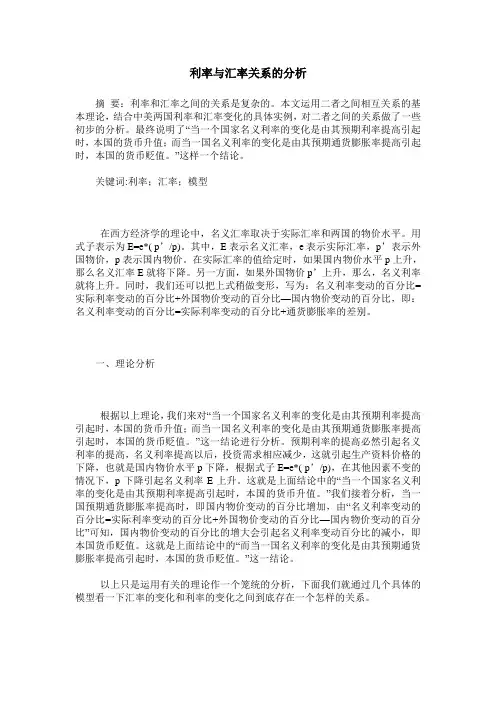
利率与汇率关系的分析摘要:利率和汇率之间的关系是复杂的。
本文运用二者之间相互关系的基本理论,结合中美两国利率和汇率变化的具体实例,对二者之间的关系做了一些初步的分析。
最终说明了“当一个国家名义利率的变化是由其预期利率提高引起时,本国的货币升值;而当一国名义利率的变化是由其预期通货膨胀率提高引起时,本国的货币贬值。
”这样一个结论。
关键词:利率;汇率;模型在西方经济学的理论中,名义汇率取决于实际汇率和两国的物价水平。
用式子表示为E=e*( p’/p)。
其中,E表示名义汇率,e表示实际汇率,p’表示外国物价,p表示国内物价。
在实际汇率的值给定时,如果国内物价水平p上升,那么名义汇率E就将下降。
另一方面,如果外国物价p’上升,那么,名义利率就将上升。
同时,我们还可以把上式稍做变形,写为:名义利率变动的百分比=实际利率变动的百分比+外国物价变动的百分比—国内物价变动的百分比,即:名义利率变动的百分比=实际利率变动的百分比+通货膨胀率的差别。
一、理论分析根据以上理论,我们来对“当一个国家名义利率的变化是由其预期利率提高引起时,本国的货币升值;而当一国名义利率的变化是由其预期通货膨胀率提高引起时,本国的货币贬值。
”这一结论进行分析。
预期利率的提高必然引起名义利率的提高,名义利率提高以后,投资需求相应减少,这就引起生产资料价格的下降,也就是国内物价水平p下降,根据式子E=e*( p’/p),在其他因素不变的情况下,p下降引起名义利率E上升。
这就是上面结论中的“当一个国家名义利率的变化是由其预期利率提高引起时,本国的货币升值。
”我们接着分析,当一国预期通货膨胀率提高时,即国内物价变动的百分比增加,由“名义利率变动的百分比=实际利率变动的百分比+外国物价变动的百分比—国内物价变动的百分比”可知,国内物价变动的百分比的增大会引起名义利率变动百分比的减小,即本国货币贬值。
这就是上面结论中的“而当一国名义利率的变化是由其预期通货膨胀率提高引起时,本国的货币贬值。
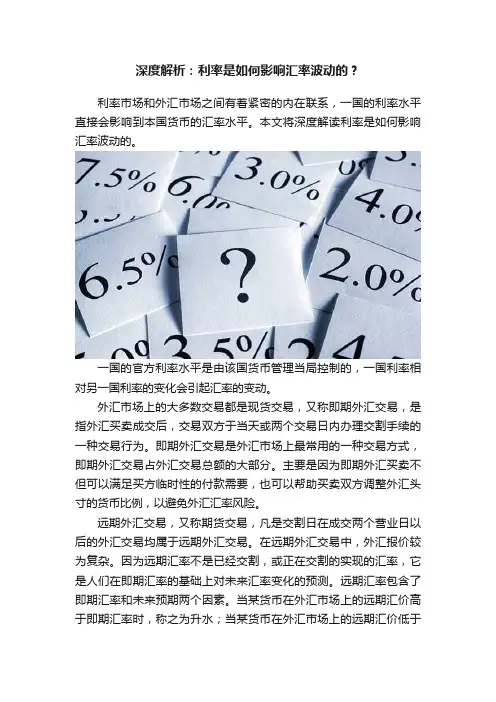
深度解析:利率是如何影响汇率波动的?利率市场和外汇市场之间有着紧密的内在联系,一国的利率水平直接会影响到本国货币的汇率水平。
本文将深度解读利率是如何影响汇率波动的。
一国的官方利率水平是由该国货币管理当局控制的,一国利率相对另一国利率的变化会引起汇率的变动。
外汇市场上的大多数交易都是现货交易,又称即期外汇交易,是指外汇买卖成交后,交易双方于当天或两个交易日内办理交割手续的一种交易行为。
即期外汇交易是外汇市场上最常用的一种交易方式,即期外汇交易占外汇交易总额的大部分。
主要是因为即期外汇买卖不但可以满足买方临时性的付款需要,也可以帮助买卖双方调整外汇头寸的货币比例,以避免外汇汇率风险。
远期外汇交易,又称期货交易,凡是交割日在成交两个营业日以后的外汇交易均属于远期外汇交易。
在远期外汇交易中,外汇报价较为复杂。
因为远期汇率不是已经交割,或正在交割的实现的汇率,它是人们在即期汇率的基础上对未来汇率变化的预测。
远期汇率包含了即期汇率和未来预期两个因素。
当某货币在外汇市场上的远期汇价高于即期汇率时,称之为升水;当某货币在外汇市场上的远期汇价低于即期汇率时,称之为贴水。
利差套利外汇市场都是由“买”和“卖”两个因素共同构成的,二者缺一不可。
当你在外汇市场上买卖货币对时,就意味你在买入某一货币,同时也在卖出某一货币。
理论上,如果你进行的现钞外汇买卖的话,那么你可以直接将其存入银行,便可产生利息。
相当于你把钱借给银行,银行需要按一定的利率支付给你利息。
你得到利息的多少取决于你把钱存入银行的时间长短,时间越长,利率越高,利息越多。
长期上看,外汇市场的波动和两国利率的变化联系密切,那些利率更高的国家的货币往往更有吸引力。
但天下没有免费的午餐,你确实可以利用两国之间的利率之差进行套利操作,当你买入一种高收益率货币时,就可以获得较高的利息,但同时,你也会面临着现货外汇市场波动的风险。
利率平价理论(Interest Rate Parity Theory)认为,在两国利率存在差异的情况下,资金将从低利率国流向高利率国以谋取利润。
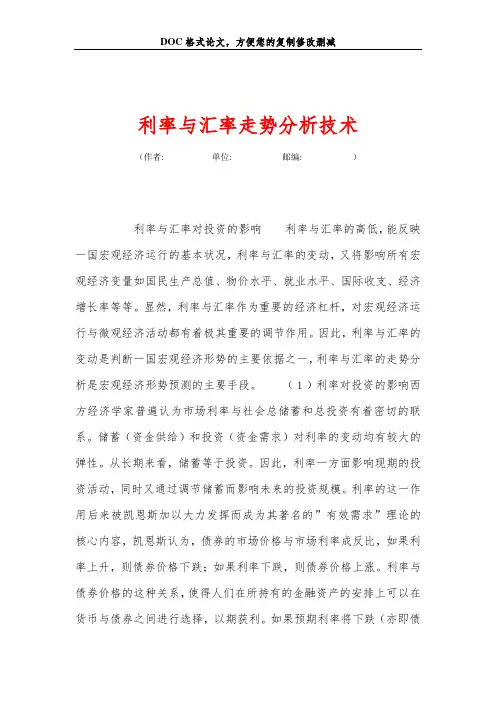
利率与汇率走势分析技术(作者:___________单位: ___________邮编: ___________)利率与汇率对投资的影响利率与汇率的高低,能反映一国宏观经济运行的基本状况,利率与汇率的变动,又将影响所有宏观经济变量如国民生产总值、物价水平、就业水平、国际收支、经济增长率等等。
显然,利率与汇率作为重要的经济杠杆,对宏观经济运行与微观经济活动都有着极其重要的调节作用。
因此,利率与汇率的变动是判断一国宏观经济形势的主要依据之一,利率与汇率的走势分析是宏观经济形势预测的主要手段。
(1)利率对投资的影响西方经济学家普遍认为市场利率与社会总储蓄和总投资有着密切的联系。
储蓄(资金供给)和投资(资金需求)对利率的变动均有较大的弹性。
从长期来看,储蓄等于投资。
因此,利率一方面影响现期的投资活动,同时又通过调节储蓄而影响未来的投资规模。
利率的这一作用后来被凯恩斯加以大力发挥而成为其著名的”有效需求”理论的核心内容,凯恩斯认为,债券的市场价格与市场利率成反比,如果利率上升,则债券价格下跌;如果利率下跌,则债券价格上涨。
利率与债券价格的这种关系,使得人们在所持有的金融资产的安排上可以在货币与债券之间进行选择,以期获利。
如果预期利率将下跌(亦即债券价格将上涨)则人们愿意现在少存货币和多买债券,以便将来债券价格上涨时卖出债券获利;反之,预期利率的上升使得人们愿意多存货币和少存债券,即把手里的债券卖出,转换为货币,以避免将来债券价格下跌时遭受损失。
从宏观角度来看,利率对投资者行为的影响表现为对投资规模、投资结构等方面的影响上。
①利率对投资规模的影响。
利率对投资规模的影响是指利率作为投资的机会成本对社会总投资的影响。
在投资收益不变的条件下,因利率上升而导致的投资成本增加,必然使那些投资收益较低的投资者退出投资领域,从而使投资需求减少。
相反,利率下跌则意味着投资成本下降,从而刺激投资,使社会总投资增加。
正是由于利率具有这一作用,西方经济理论界与货币管理当局都把利率视为衡量经济运行状况的一个重要指标和调节经济运行的重要手段。
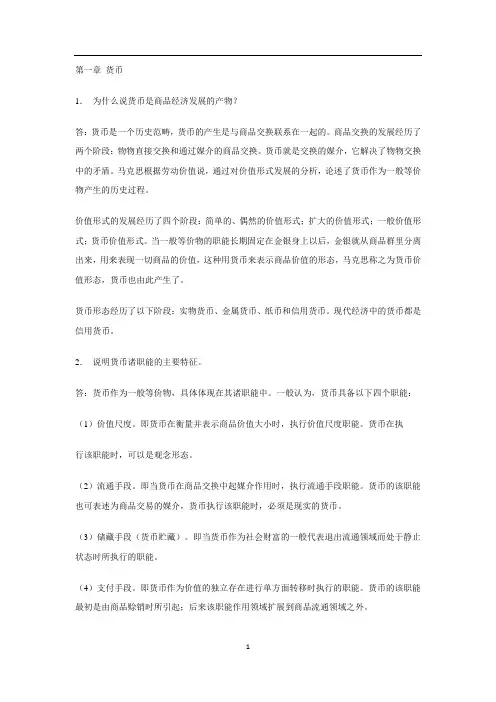
第一章货币1.为什么说货币是商品经济发展的产物?答:货币是一个历史范畴,货币的产生是与商品交换联系在一起的。
商品交换的发展经历了两个阶段:物物直接交换和通过媒介的商品交换。
货币就是交换的媒介,它解决了物物交换中的矛盾。
马克思根据劳动价值说,通过对价值形式发展的分析,论述了货币作为一般等价物产生的历史过程。
价值形式的发展经历了四个阶段:简单的、偶然的价值形式;扩大的价值形式;一般价值形式;货币价值形式。
当一般等价物的职能长期固定在金银身上以后,金银就从商品群里分离出来,用来表现一切商品的价值,这种用货币来表示商品价值的形态,马克思称之为货币价值形态,货币也由此产生了。
货币形态经历了以下阶段:实物货币、金属货币、纸币和信用货币。
现代经济中的货币都是信用货币。
2.说明货币诸职能的主要特征。
答:货币作为一般等价物,具体体现在其诸职能中。
一般认为,货币具备以下四个职能:(1)价值尺度。
即货币在衡量并表示商品价值大小时,执行价值尺度职能。
货币在执行该职能时,可以是观念形态。
(2)流通手段。
即当货币在商品交换中起媒介作用时,执行流通手段职能。
货币的该职能也可表述为商品交易的媒介,货币执行该职能时,必须是现实的货币。
(3)储藏手段(货币贮藏)。
即当货币作为社会财富的一般代表退出流通领域而处于静止状态时所执行的职能。
(4)支付手段。
即货币作为价值的独立存在进行单方面转移时执行的职能。
货币的该职能最初是由商品赊销时所引起;后来该职能作用领域扩展到商品流通领域之外。
3.阐明货币的对内价值与对外价值的联系与区别答:货币具有对内价值和对外价值。
货币对内价值通常是指货币购买力,即货币在一定价格水平下购买商品、劳务的能力;货币对外价值通常是指汇率,即两国货币折算的比率。
货币的对内价值与对外价值之间既有内在联系又有区别。
在不兑现信用货币流通下,只能通过比较两国货币购买力,或者说两国物价水平来间接测定汇价。
所以,一国汇价与国内物价有着内在联系。
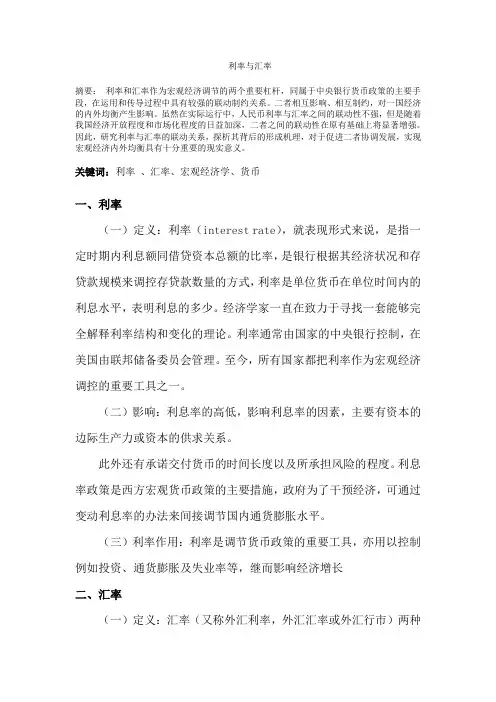
利率与汇率摘要:利率和汇率作为宏观经济调节的两个重要杠杆,同属于中央银行货币政策的主要手段,在运用和传导过程中具有较强的联动制约关系。
二者相互影响、相互制约,对一国经济的内外均衡产生影响。
虽然在实际运行中,人民币利率与汇率之间的联动性不强,但是随着我国经济开放程度和市场化程度的日益加深,二者之间的联动性在原有基础上将显著增强。
因此,研究利率与汇率的联动关系,探析其背后的形成机理,对于促进二者协调发展,实现宏观经济内外均衡具有十分重要的现实意义。
关键词:利率、汇率、宏观经济学、货币一、利率(一)定义:利率(interest rate),就表现形式来说,是指一定时期内利息额同借贷资本总额的比率,是银行根据其经济状况和存贷款规模来调控存贷款数量的方式,利率是单位货币在单位时间内的利息水平,表明利息的多少。
经济学家一直在致力于寻找一套能够完全解释利率结构和变化的理论。
利率通常由国家的中央银行控制,在美国由联邦储备委员会管理。
至今,所有国家都把利率作为宏观经济调控的重要工具之一。
(二)影响:利息率的高低,影响利息率的因素,主要有资本的边际生产力或资本的供求关系。
此外还有承诺交付货币的时间长度以及所承担风险的程度。
利息率政策是西方宏观货币政策的主要措施,政府为了干预经济,可通过变动利息率的办法来间接调节国内通货膨胀水平。
(三)利率作用:利率是调节货币政策的重要工具,亦用以控制例如投资、通货膨胀及失业率等,继而影响经济增长二、汇率(一)定义:汇率(又称外汇利率,外汇汇率或外汇行市)两种货币之间的对换的比率,亦可视为一个国家的货币对另一种货币的价值。
汇率又是各个国家为了达到其政治目的金融手段。
汇率会因为利率,通货膨胀,国家的政治和每个国家的经济等原因而变动。
而汇率是由外汇市场决定。
外汇市场开放予不同类型的买家和卖家以作广泛及连续的货币交易(外汇交易除周末外每天24小时进行,即从GMT时间周日8:15至GMT时间周五22:00。
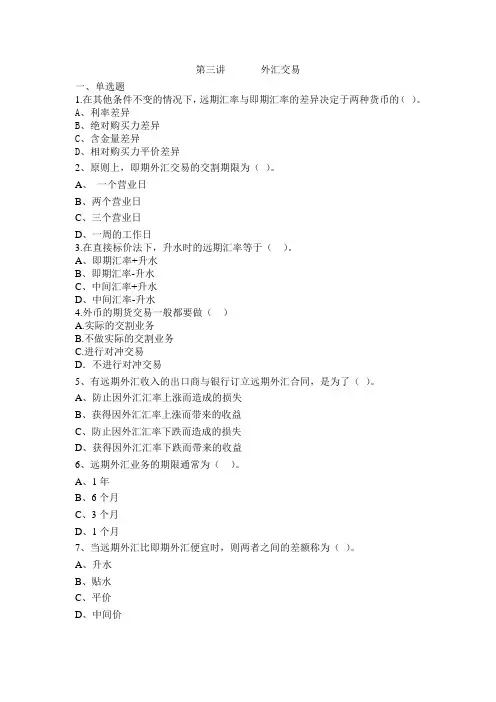
第三讲外汇交易一、单选题1.在其他条件不变的情况下,远期汇率与即期汇率的差异决定于两种货币的()。
A、利率差异B、绝对购买力差异C、含金量差异D、相对购买力平价差异2、原则上,即期外汇交易的交割期限为()。
A、一个营业日B、两个营业日C、三个营业日D、一周的工作日3.在直接标价法下,升水时的远期汇率等于()。
A、即期汇率+升水B、即期汇率-升水C、中间汇率+升水D、中间汇率-升水4.外币的期货交易一般都要做()A.实际的交割业务B.不做实际的交割业务C.进行对冲交易D.不进行对冲交易5、有远期外汇收入的出口商与银行订立远期外汇合同,是为了()。
A、防止因外汇汇率上涨而造成的损失B、获得因外汇汇率上涨而带来的收益C、防止因外汇汇率下跌而造成的损失D、获得因外汇汇率下跌而带来的收益6、远期外汇业务的期限通常为()。
A、1年B、6个月C、3个月D、1个月7、当远期外汇比即期外汇便宜时,则两者之间的差额称为()。
A、升水B、贴水C、平价D、中间价8、通常情况下,远期汇率与即期汇率的差价表现为贴水的是()。
A、低利率国家的货币B、高利率国家的货币C、实行浮动汇率制国家的货币D、实行钉住汇率制国家的货币9、套汇交易赚取利润所依据的是不同市场的()。
A、汇率差异B、利率差异C、汇率及利率差异D、通货膨胀率差异10、组成掉期交易的两笔外汇业务的()。
A、交割日期相同B、金额相同C、交割汇率相同D、买卖方向相同二、多选题1. 货币期货交易的特点有()。
A、买卖双方无直接合同责任关系B、对远期外汇的买卖有标准化规定C、不收手续费D、实行双向报价E、最后要进行交割2、在外汇市场上,远期外汇的卖出者主要有()。
A、进口商B、出口商C、持有外币债权的债权人D、负有外币债务的债务人E、对远期汇率看跌的投机商3、在外汇市场上,远期外汇的购买者主要有()。
A、进口商B、出口商C、持有外币债权的债权人D、负有外币债务的债务人E、对远期汇率看涨的投机商4、促使期权保险费费率上升的因素有()。
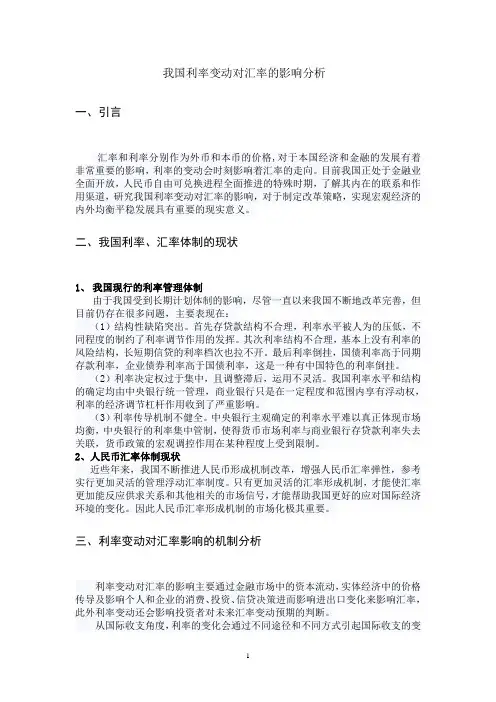
我国利率变动对汇率的影响分析一、引言汇率和利率分别作为外币和本币的价格,对于本国经济和金融的发展有着非常重要的影响,利率的变动会时刻影响着汇率的走向。
目前我国正处于金融业全面开放,人民币自由可兑换进程全面推进的特殊时期,了解其内在的联系和作用渠道,研究我国利率变动对汇率的影响,对于制定改革策略,实现宏观经济的内外均衡平稳发展具有重要的现实意义。
二、我国利率、汇率体制的现状1、我国现行的利率管理体制由于我国受到长期计划体制的影响,尽管一直以来我国不断地改革完善,但目前仍存在很多问题,主要表现在:(1)结构性缺陷突出。
首先存贷款结构不合理,利率水平被人为的压低,不同程度的制约了利率调节作用的发挥。
其次利率结构不合理,基本上没有利率的风险结构,长短期信贷的利率档次也拉不开。
最后利率倒挂,国债利率高于同期存款利率,企业债券利率高于国债利率,这是一种有中国特色的利率倒挂。
(2)利率决定权过于集中,且调整滞后,运用不灵活。
我国利率水平和结构的确定均由中央银行统一管理,商业银行只是在一定程度和范围内享有浮动权,利率的经济调节杠杆作用收到了严重影响。
(3)利率传导机制不健全。
中央银行主观确定的利率水平难以真正体现市场均衡,中央银行的利率集中管制,使得货币市场利率与商业银行存贷款利率失去关联,货币政策的宏观调控作用在某种程度上受到限制。
2、人民币汇率体制现状近些年来,我国不断推进人民币形成机制改革,增强人民币汇率弹性,参考实行更加灵活的管理浮动汇率制度。
只有更加灵活的汇率形成机制,才能使汇率更加能反应供求关系和其他相关的市场信号,才能帮助我国更好的应对国际经济环境的变化。
因此人民币汇率形成机制的市场化极其重要。
三、利率变动对汇率影响的机制分析利率变动对汇率的影响主要通过金融市场中的资本流动,实体经济中的价格传导及影响个人和企业的消费、投资、信贷决策进而影响进出口变化来影响汇率,此外利率变动还会影响投资者对未来汇率变动预期的判断。

利率上升对汇率产生的影响利率的变动会给汇率带来很多影响,具体是怎么样影响的?下面就让本人带大家一起具体地去了解一下利率上升对汇率的影响吧。
利率上升对汇率的影响在外汇市场上,一国货币利率的变动会引起其汇率的变动。
一般情况,一国货币如果升息,则该货币的汇率容易上升;而当一国货币降息时,则该国货币容易贬值。
以英镑为例,今年英镑的基本利率已经降至5%以下水平,其兑美元的汇率也跌到了1英镑兑1.50美元之下。
只要世界上发生较大的政治事件,资金都会流入美国以规避风险,因此美元就因为发挥"资金避难所"的角色而汇率上升。
而西欧由于传统上与东欧及前苏联国家在经济、贸易、政治等各方面都有千丝万缕的关系,一旦苏东发生动乱,西欧必然受到波及,欧洲国家货币的汇率就会应声下跌。
这已经一再为国际金融市场所证实。
比如说99年的南斯拉夫科索沃地区冲突并演变成西方国家对南斯拉夫的战争对欧元的影响。
本来从整体看欧元区国家的经济实力并不比美国差,因此在98年底欧元诞生前不乏分析师看好欧元,但是一方面是欧元区诞生的先天不足,另外一方面就是由于科索沃问题的影响。
由于这场战争旷日持久,资金就不断从欧洲流出,到美国投资,从现象上看,美国股票市场不断创出历史新高,美元汇率不断上升,而欧元从诞生之日起就一路贬值。
直到科索沃战争结束,欧元才略有喘气的机会。
汇率变动对利率的影响也是间接地作用,即通过影响国内物价水平、影响短期资本流动而间接地对利率产生影响。
首先,当一国货币汇率下降时,有利于促进出口、限制进口,进口商品成本上升,推动一般物价水平上升,引起国内物价水平的上升,从而导致实际利率下降。
这种状况有利于债务人、不利于债权人,从而造成借贷资本供求失衡,最终导致名义利率的上升。
如果一国货币汇率上升,对利率的影响正好与上述情况相反。
其次,当一国货币汇率下降之后,受心理因素的影响,往往使人们产生该国货币汇率进一步下降的预期,在本币贬值预期的作用之下,引起短期资本外逃,国内资金供应的减少将推动本币利率的上升。
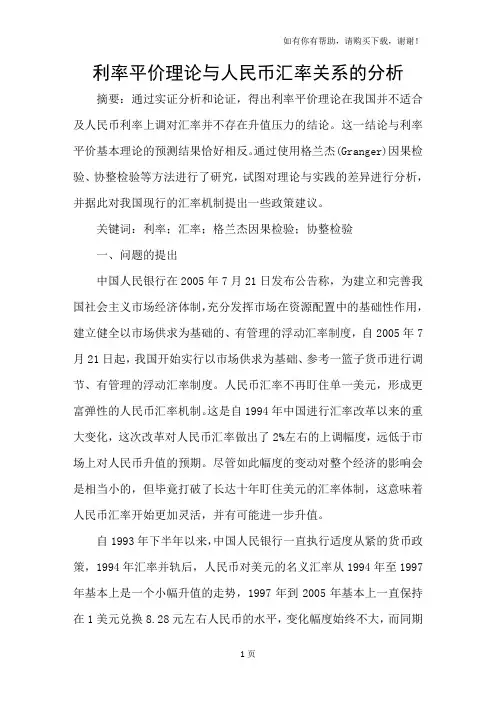
利率平价理论与人民币汇率关系的分析摘要:通过实证分析和论证,得出利率平价理论在我国并不适合及人民币利率上调对汇率并不存在升值压力的结论。
这一结论与利率平价基本理论的预测结果恰好相反。
通过使用格兰杰(Granger)因果检验、协整检验等方法进行了研究,试图对理论与实践的差异进行分析,并据此对我国现行的汇率机制提出一些政策建议。
关键词:利率;汇率;格兰杰因果检验;协整检验一、问题的提出中国人民银行在2005年7月21日发布公告称,为建立和完善我国社会主义市场经济体制,充分发挥市场在资源配置中的基础性作用,建立健全以市场供求为基础的、有管理的浮动汇率制度,自2005年7月21日起,我国开始实行以市场供求为基础、参考一篮子货币进行调节、有管理的浮动汇率制度。
人民币汇率不再盯住单一美元,形成更富弹性的人民币汇率机制。
这是自1994年中国进行汇率改革以来的重大变化,这次改革对人民币汇率做出了2%左右的上调幅度,远低于市场上对人民币升值的预期。
尽管如此幅度的变动对整个经济的影响会是相当小的,但毕竟打破了长达十年盯住美元的汇率体制,这意味着人民币汇率开始更加灵活,并有可能进一步升值。
自1993年下半年以来,中国人民银行一直执行适度从紧的货币政策,1994年汇率并轨后,人民币对美元的名义汇率从1994年至1997年基本上是一个小幅升值的走势,1997年到2005年基本上一直保持在1美元兑换8.28元左右人民币的水平,变化幅度始终不大,而同期人民币利率却发生了很大的变化:1993年7月和1995年1月中国人民银行两度提高利率,使得人民币利率远远高于美元利率。
而自1996年5月起,中国人民银行更是先后7次降低利率。
仅从1997年下半年开始,为了刺激国内外的需求,拉动国内经济的增长,央行就连续6次降息。
此后与连续降息同时出现的是人民币汇率的持续稳定。
除了1997~1999年人民币利率水平是低于美元利率水平外,我国人民币利率水平一直明显高于美元利率水平。
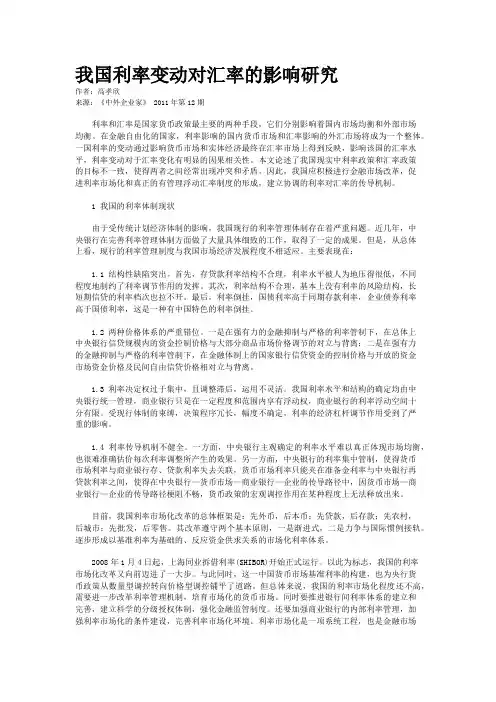
我国利率变动对汇率的影响研究作者:高孝欣来源:《中外企业家》 2011年第12期利率和汇率是国家货币政策最主要的两种手段,它们分别影响着国内市场均衡和外部市场均衡。
在金融自由化的国家,利率影响的国内货币市场和汇率影响的外汇市场将成为一个整体。
一国利率的变动通过影响货币市场和实体经济最终在汇率市场上得到反映,影响该国的汇率水平,利率变动对于汇率变化有明显的因果相关性。
本文论述了我国现实中利率政策和汇率政策的目标不一致,使得两者之间经常出现冲突和矛盾。
因此,我国应积极进行金融市场改革,促进利率市场化和真正的有管理浮动汇率制度的形成,建立协调的利率对汇率的传导机制。
1 我国的利率体制现状由于受传统计划经济体制的影响,我国现行的利率管理体制存在着严重问题。
近几年,中央银行在完善利率管理体制方面做了大量具体细致的工作,取得了一定的成果。
但是,从总体上看,现行的利率管理制度与我国市场经济发展程度不相适应。
主要表现在:1.1 结构性缺陷突出。
首先,存贷款利率结构不合理,利率水平被人为地压得很低,不同程度地制约了利率调节作用的发挥。
其次,利率结构不合理,基本上没有利率的风险结构,长短期信贷的利率档次也拉不开。
最后,利率倒挂,国债利率高于同期存款利率,企业债券利率高于国债利率,这是一种有中国特色的利率倒挂。
1.2 两种价格体系的严重错位。
一是在强有力的金融抑制与严格的利率管制下,在总体上中央银行信贷规模内的资金控制价格与大部分商品市场价格调节的对立与背离;二是在强有力的金融抑制与严格的利率管制下,在金融体制上的国家银行信贷资金的控制价格与开放的资金市场资金价格及民间自由信贷价格相对立与背离。
1.3 利率决定权过于集中,且调整滞后,运用不灵活。
我国利率水平和结构的确定均由中央银行统一管理,商业银行只是在一定程度和范围内享有浮动权,商业银行的利率浮动空间十分有限。
受现行体制的束缚,决策程序冗长,幅度不确定,利率的经济杠杆调节作用受到了严重的影响。
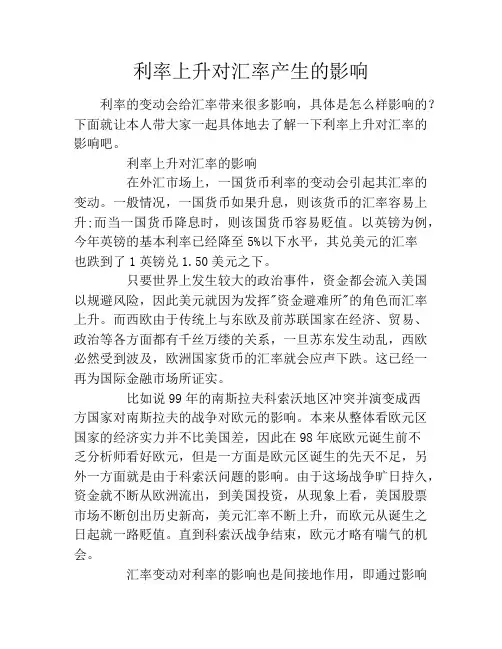
利率上升对汇率产生的影响利率的变动会给汇率带来很多影响,具体是怎么样影响的?下面就让本人带大家一起具体地去了解一下利率上升对汇率的影响吧。
利率上升对汇率的影响在外汇市场上,一国货币利率的变动会引起其汇率的变动。
一般情况,一国货币如果升息,则该货币的汇率容易上升;而当一国货币降息时,则该国货币容易贬值。
以英镑为例,今年英镑的基本利率已经降至5%以下水平,其兑美元的汇率也跌到了1英镑兑1.50美元之下。
只要世界上发生较大的政治事件,资金都会流入美国以规避风险,因此美元就因为发挥"资金避难所"的角色而汇率上升。
而西欧由于传统上与东欧及前苏联国家在经济、贸易、政治等各方面都有千丝万缕的关系,一旦苏东发生动乱,西欧必然受到波及,欧洲国家货币的汇率就会应声下跌。
这已经一再为国际金融市场所证实。
比如说99年的南斯拉夫科索沃地区冲突并演变成西方国家对南斯拉夫的战争对欧元的影响。
本来从整体看欧元区国家的经济实力并不比美国差,因此在98年底欧元诞生前不乏分析师看好欧元,但是一方面是欧元区诞生的先天不足,另外一方面就是由于科索沃问题的影响。
由于这场战争旷日持久,资金就不断从欧洲流出,到美国投资,从现象上看,美国股票市场不断创出历史新高,美元汇率不断上升,而欧元从诞生之日起就一路贬值。
直到科索沃战争结束,欧元才略有喘气的机会。
汇率变动对利率的影响也是间接地作用,即通过影响国内物价水平、影响短期资本流动而间接地对利率产生影响。
首先,当一国货币汇率下降时,有利于促进出口、限制进口,进口商品成本上升,推动一般物价水平上升,引起国内物价水平的上升,从而导致实际利率下降。
这种状况有利于债务人、不利于债权人,从而造成借贷资本供求失衡,最终导致名义利率的上升。
如果一国货币汇率上升,对利率的影响正好与上述情况相反。
其次,当一国货币汇率下降之后,受心理因素的影响,往往使人们产生该国货币汇率进一步下降的预期,在本币贬值预期的作用之下,引起短期资本外逃,国内资金供应的减少将推动本币利率的上升。